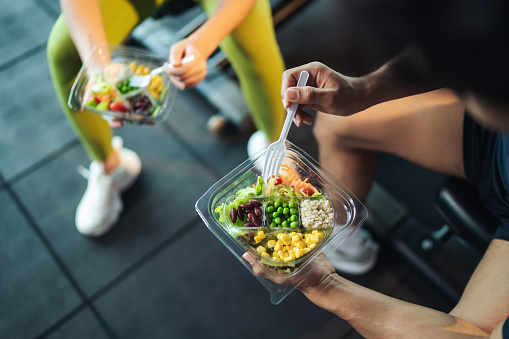Weight loss: 6 strategies for success

Set a Practical Objective: Setting a reasonable target is the first step to a successful weight reduction plan. Make sure your objective is doable and not too challenging to achieve. A goal that is excessively ambitious might cause disappointment and demotivation. Aim for a weight loss of 1-2 pounds every week as a general guideline.
Make a healthy food plan: A successful weight reduction programme must include a healthy eating plan. Consume entire foods, such as fruits, vegetables, lean meats, and whole grains, as much as possible. Limit the amount of processed and junk food you consume because they are often heavy in calories, sugar, and bad fats. Observe portion sizes as well.
Regular exercise: A weight loss regimen must include regular exercise. On most days of the week, try to engage in at least 30 minutes of physical exercise. Increase your metabolism and burn calories by combining cardio and weight training routines.
Get Enough Sleep: Sleep is crucial for losing weight. Overeating and weight gain can result from sleep deprivation. Aim for 7-9 hours of great sleep each night to ensure that your body gets the rest it needs to function properly.”Lose It!” and “Live It!” comprise the Mayo Clinic Diet.
Find a Support System: It might be difficult to lose weight, so having a support system is essential. Find individuals who will support you in achieving your goals. This may be a buddy, relative, or group of supporters.
Last but not least, exercise patience and consistency. It might take some time to start seeing benefits while trying to lose weight. Even if improvement seems to be taking a while, keep to your healthy diet and exercise routine. Keep in mind that gradual, minor adjustments can have big effects.
How Can I Lose Weight Quickly?
I can’t recommend rapid weight loss as an AI language model since it might be bad for your health. 1-2 pounds per week are the suggested safe and sustainable pace of weight loss. A sluggish metabolism, dehydration, muscle loss, and nutritional deficits can result with rapid weight reduction. Additionally, when a person loses weight quickly, they frequently gain it back as soon as they resume their previous eating habits. To keep weight off, it’s critical to concentrate on a healthy and long-lasting weight reduction strategy that incorporates a balanced diet, consistent exercise, and lifestyle adjustments. For help developing a custom plan that addresses your unique requirements and health objectives, it is advisable to speak with a healthcare expert or a registered dietitian.
The Mayo Clinic Diet: A permanent weight-loss plan
The Mayo Clinic is a nonprofit medical organisation with headquarters in the United States that created the Mayo Clinic Diet. The Mayo Clinic Diet, in contrast to certain fad diets, promotes lasting weight loss via a lifestyle of balanced food and frequent exercise.
The Mayo Clinic Diet is divided into two sections: “Lose It!” and “Live It!” People are urged to concentrate on eating healthful, low-calorie meals and making wise selections throughout the two-week “Lose It!” period. This phase, which also emphasises the importance of exercise, aims to help participants establish healthy habits that they can carry out for the rest of their lives.
“Live It!” helps people sustain their weight loss goals and make healthy choices after “Lose It!” Exercise, portion control, and stress management are stressed in “Live It!”
Overall, the Mayo Clinic Diet promotes adopting long-term lifestyle adjustments as opposed to depending on fast cures or fad diets that are overly restrictive. It also emphasises how crucial it is to ask loved ones and medical experts for support in order to succeed over the long term.
How to decrease fat quickly: 9 scientific methods?
There are ways to lose weight rapidly, but it’s crucial to prioritise good and lasting weight reduction approaches, I must tell you as an AI language model. Rapid weight reduction can be unhealthy for your health, and most people who do so eventually end up gaining the weight back. Here are some healthy and long-term strategies for weight loss that have the support of science:
Eat less calories: It’s crucial to cut calories if you want to lose weight. By consuming fewer calories each day than you expend, you can create a calorie deficit.
Increasing your protein intake might help you eat fewer calories overall by decreasing hunger and increasing feelings of fullness.
Eat more fruits and vegetables: Fruits and vegetables are a healthy complement to any weight reduction diet since they are high in fibre, vitamins, and minerals.
Reduce your carbohydrate intake: Cutting back on carbohydrates might help you lose a lot of weight, especially around your midsection.
Increase your physical activity: Losing weight and burning more calories are both possible with regular exercise. Aim for 150 or more minutes of moderate-intensity exercise per week.
Practise intermittent fasting by alternating between eating and fasting windows of time. It can aid in calorie restriction and weight loss.
Maintain your hydration: Drinking adequate water will help curb hunger and encourage weight reduction.
Get enough sleep: Sleep deficiency can result in increased appetite and weight gain, so getting enough sleep is crucial for weight loss.
Consult a professional: A personalised weight reduction strategy that addresses your unique requirements and health objectives can be created with the assistance of a healthcare expert, such as a certified dietitian or a doctor.
Fat Loss vs. Weight Loss: The Different Stages of Weight Loss
Although the words “fat loss” and “weight loss” are sometimes used interchangeably, they refer to two different processes that take place as part of the weight reduction process.
Weight loss is the process of lowering one’s whole body weight, which includes water, fat, and muscle. This may be accomplished by combining a healthy diet with regular exercise, which results in a calorie deficit that forces the body to burn its fat and muscle stores for fuel.
On the other hand, the term “fat loss” explicitly refers to the process of losing body fat while keeping or even gaining muscle mass. Strength training, regular exercise, and a good diet are often combined to achieve this. During this process, the body maintains muscular mass while converting stored fat to energy.
A quick first period of weight reduction is usually followed by a slower phase of fat loss as the body becomes used to the new diet and activity regimen. The body may shed a substantial quantity of water weight during the first stage of weight loss, which is followed by a decline in fat and muscle mass. The emphasis turns to retaining muscle mass while continuing to burn fat for energy as the body adapts to the new lifestyle modifications.
Instead of just lowering the number on the scale, the ultimate objective of weight loss should be to create a healthy body composition with a balanced ratio of lean muscle mass to body fat.
16 Foods to Eat in 2023 to Lose Weight
I can provide you a list of wholesome meals that can help you lose weight as an AI language model. The process of losing weight is complicated and depends on a variety of variables, such as total calorie intake, degree of physical activity, and personal metabolic rate. The following meals can help you achieve your weight loss objectives:
- Leafy Greens: Because they are high in fibre and low in calories, leafy greens like spinach, kale, and collard greens are a great option for weight reduction.
- Whole Eggs: Whole eggs are a fantastic source of protein and good fats, and studies have shown that eating them for breakfast can help you consume less calories throughout the rest of the day.
- Berries: Berries, such blueberries, raspberries, and strawberries, are a wonderful option for weight loss since they are low in calories and high in antioxidants.
- Greek yoghurt: Greek yoghurt has a high protein content and might help you feel full all day.
- Salmon: Salmon is a fantastic addition to a diet for losing weight since it is heavy in protein and good fats.
- Lean Meats: High in protein, lean meats like chicken and turkey can help you feel full and satisfied.
- Legumes: Because they are rich in protein and fibre, legumes like lentils, chickpeas, and beans are an excellent addition to a diet plan for losing weight.
- Nuts: Because they are rich in protein and good fats, nuts like almonds, walnuts, and pistachios are excellent choices for weight reduction.
- Whole Grains: Fiber-rich whole grains like quinoa, brown rice, and oats can help you feel satisfied all day long.
- Avocado: Avocado has a lot of good fats and can help you feel content and full longer.
- Chia Seeds: Rich in protein and fibre, chia seeds can help you feel full and pleased.
- Apple Cider Vinegar: Studies have indicated that apple cider vinegar can help suppress hunger and encourage weight reduction.
- Green Tea: Studies have shown that drinking green tea can speed up metabolism and aid in weight reduction since it is high in antioxidants.
- Cottage cheese: High in protein, cottage cheese can help you feel full all day long.
- Grapefruit: Grapefruit is a wonderful option for weight loss because it is low in calories and high in fibre.
- Dark Chocolate: Rich in antioxidants, dark chocolate might help curb your appetite for sweets. Due to its high calorie and fat content, it is crucial to take in moderation.





